Isotopic Abundance Ratio Evaluation of the Consciousness Energy Treated Pyridoxine Using LC-MS and GC-MS Spectrometry
Mahendra Kumar Trivedi1, Alice Branton1, Dahryn Trivedi1 and Snehasis Jana2*
1Trivedi Global Inc, Henderson, USA
2Trivedi Science Research Laboratory Pvt Ltd, India
Submission: February 01, 2021;Published: February 11, 2021
*Corresponding author:Snehasis Jana, Trivedi Science Research Laboratory Pvt. Ltd., Thane(W), Maharashtra, India
How to cite this article:Mahendra KT, Alice B, Dahryn T, Snehasis J. Isotopic Abundance Ratio Evaluation of the Consciousness Energy Treated Pyridoxine Using LC-MS and GC-MS Spectrometry. Glob J Pharmaceu Sci. 2020; 8(2): 555731. DOI: 10.19080/GJPPS.2021.08.555731.
Abstract
Vitamin B6 (pyridoxine) has an important role in physiologic development. In this study, the influence of the Trivedi Effect®- Consciousness Energy Treatment on the structural properties and the isotopic abundance ratio of pyridoxine were evaluated using LC-MS and GC-MS analytical techniques. The test sample pyridoxine was divided into Control / untreated and the Biofield Energy Treated sample. The treated pyridoxine sample received Biofield Energy Treatment (the Trivedi Effect®) remotely for ~3 minutes by Mr. Mahendra Kumar Trivedi, who was in the USA, while the test samples were in the research laboratory in India. The LC-MS spectra of both the samples at retention time ~2.33 minutes exhibited the mass of the protonated molecular ion peak [M+H] + at m/z 170 in the MS spectrum. The isotopic abundance ratio of PM+1/PM in the treated pyridoxine was significantly increased by 14.44% compared with the control sample. Thus, 13C, 2H, 15N, and 17O contributions from (C8H12NO3) + to m/z 171 in the treated sample were significantly increased compared with the control sample. Similarly, in the GC-MS chromatograms, the peak area of the treated sample was significantly increased by 100.63% compared to the control sample. Similarly, the mass peak intensity of the treated pyridoxine at m/z 153 was increased by 1.1% compared to the control sample. The isotopic abundance ratio of PM+1/PM (2H/1H or 13C/12C or 15N/14N or 17O/16O) and peak area in the treated pyridoxine was significantly increased compared to the control sample. The decreased isotopic abundance ratio of the treated pyridoxine may increase the intra-atomic bond strength, increase its physical stability. The increased peak area of the treated pyridoxine might be responsible for the increase in solubility and bioavailability compared to the control sample. The new form of pyridoxine would be better for designing more efficacious nutraceutical formulations for the prevention and treatment of pyridoxine deficiency, anemia, seizures, cardiovascular disease, tuberculosis, Alzheimer’s disease, cancer, anxiety, hypertension, asthma, depression, dysmenorrhea, breast pain, etc.
Keywords:The Trivedi effect®; Biofield energy; Consciousness energy treatment; Pyridoxine; Isotopic abundance
Introduction
Vitamin B6 (Pyridoxine) is a water-soluble vitamin and has an important role in the physiological development [1]. It is naturally found as pyridoxal, pyridoxine, and pyridoxamine; all the forms converted into the active form pyridoxal phosphate in the human body [2]. Pyridoxine commonly found in fish, poultry, meat, tofu, chickpeas, nuts, bananas, whole grains, spinach, and dietary supplements [2,3]. Pyridoxal phosphate acts as a coenzyme for more than 100 enzymatic reactions; maintaining healthy levels of homocysteine, the amino acid in the blood; biosynthesis of neurotransmitters; gluconeogenesis, glycogenolysis, immune function, hemoglobin formation; involved in the metabolism of amino acid, carbohydrates, and lipids [2-5]. Pyridoxine hydrochloride is a salt form of pyridoxine commonly used in the pharmaceutical industries [6]. It is used for the prevention and treatment of pyridoxine deficiency diseases, Alzheimer’s disease, sideroblastic anemia, anxiety, asthma, cardiovascular disease, tuberculosis, diabetes, hyper homo cysteinaemia, cancer, pyridoxine-dependent epilepsy, depression, attention deficit hyperactivity disorder, osteoporosis, dysmenorrhea, post-partum lactation suppression, McArdle’s disease, nausea and vomiting in pregnancy, mushroom poisoning, problems from isoniazid, etc. [1,3-8]. Pyridoxine rarely shows side effects, but it can interact with the drugs like valproic acid, carbamazepine, phenytoin, cycloserine, etc. [3,5]. It is very sensitive to light. It is soluble in water and alcohol, sparingly soluble acetone and insoluble in ether and chloroform. When it heated to decomposition, it emits very toxic oxide fumes of nitrogen and hydrogen chloride [9]. The physicochemical properties of any drug material play a vital role in the solubility, absorption, bioavailability, etc. Improvement of the quality of drug is the biggest challenge for the pharmaceutical and nutraceutical scientists. The Trivedi Effect®-Consciousness Energy Treatment has the significant impact on the physicochemical properties, and bioavailability of pharmaceutical/nutraceutical compounds [10-14]. Whereas the Trivedi Effect® is a natural and only scientifically proven phenomenon in which an expert can control and make use of this inherently intelligent energy anywhere on the planet via the possible mediation of neutrinos [15]. Continuous moment of the ions, cells, blood, heart, etc. in the human body form a quantum of energy matrix around the body is called the “Biofield Energy” [16,17]. Biofield Energy Healers can pass this energy into any living or nonliving object(s) anywhere on the planet, and the overall process is called Biofield Energy Treatment [17,18]. This treatment has significant positive outcomes against various disease [19]. The National Center of Complementary and Integrative Health has recognized and accepted Biofield Energy as a Complementary and Alternative Medicine (CAM) health care approach along with the other therapies, medicines, and practices, such as yoga, Ayurveda, Qi Gong, Tai Chi, etc. [20,21]. Most of the USA population has accepted these CAM therapies [22,23]. The Trivedi Effect® also have reported with significant scientific results altering the physicochemical and thermal properties of the several non-living and living object(s), i.e., organic compounds, metals, ceramic, polymers, crops, microbes, cancer cells [24-30], and altered the isotopic abundance ratio [31,32]. To understand the isotope effects resulting from the variation of the isotopic composition of the molecule, the stable isotope ratio analysis is important, and it has many applications in different field of science [33,34]. The isotope ratio analysis usually performed by using the gas chromatography-mass spectrometry (GC-MS) and liquid chromatography-mass spectrometry (LC-MS) in low micromolar concentration with sufficient precision [34,35]. Therefore, the structural properties characterization and the isotopic abundance ratio analysis of PM+1/PM (2H/1H or 13C/12C or 15N/14N or 17O/16O) in the Trivedi Effect®-Consciousness Energy Treated pyridoxine was performed compared to the control sample using LC-MS and GC-MS analytical techniques.
Materials and Methods
Chemicals and reagents
The test sample pyridoxine hydrochloride (100%) was purchased from TCI, Japan. Methanol, acetonitrile, and ammonium acetate were purchased from Merck India.
Consciousness energy treatment strategies
The test sample pyridoxine hydrochloride powder was divided into two parts. One part did not receive the Biofield Energy Treatment and therefore considered as the Control pyridoxine. The second part of the test compound received the Energy of Consciousness Treatment remotely for ~3 minutes through the Unique Energy Transmission process by Mr. Mahendra Kumar Trivedi, who was located in the USA, while the test samples were located in the research laboratory in India, and it was labelled as the Biofield Energy Treated pyridoxine On the other hand, the Control sample was subjected to “sham” healer, who did not have any knowledge about the Biofield Energy Treatment, under the similar laboratory conditions. After that, the Biofield Energy Treated and un-treated pyridoxine samples were kept in sealed conditions and characterized using LC-MS and GC-MS analytical techniques.
Characterization
Liquid chromatography-mass spectrometry (lc-ms) analysis and calculation of Isotopic abundance ratio
The LC-MS analysis of pyridoxine was carried out with the help of LC-MS Thermo Fisher Scientific (USA) equipped with an ion trap detector connected with a triple-stage quadrupole mass spectrometer. The reversed phase column Thermo Scientific Synchronis C18 (Length-250mm X ID 4.6mm X 5micron), maintained at 25˚C was used. Methanol and water were used as diluent for the sample preparation. 10μL of pyridoxine solution was injected, and the analyte was eluted using acetonitrile + 5 mM ammonium acetate (80:20) pumped at a constant flow rate of 1mL/min. Chromatographic separation was achieved using gradient condition and the total run time was 10min. Peaks were monitored at 220nm using the PDA detector. The mass spectrometric analysis was performed under +ve ESI mode. The values of the natural isotopic abundance of the common elements are obtained from the literature [34, 36-38]. The LC-MS based isotopic abundance ratio (PM+1/PM) for both the samples was calculated using equation 1.

Where IAR Control and IAR Treated is the isotopic abundance ratio in the treated and control pyridoxine sample, respectively.
Gas chromatography-mass spectrometry (GC-MS) analysis
GC-MS of the pyridoxine samples were analyzed with the help of Perkin Elmer Gas chromatograph equipped with a PE- 5MS (30M x 250 micros x 0.250 microns) capillary column and coupled to a single quadrupole mass detector was operated with electron impact (EI) ionization in positive mode. The oven temperature was programmed from 75°C (5min hold) to 250°C (2.5 min hold) @ 10°C /min (total run time 25min). The sample was prepared taking 100mg of the pyridoxine in 4ml methanol as a diluent. Injection volume was 5μl. The % change in the peak area and mass peak intensities of the treated pyridoxine was calculated compared to the control sample using the following equation 2.
% Change = [Treated -Control] / Control ×100 (2)
Results and Discussion
Liquid chromatography-mass spectrometry (LC-MS)
The pyridoxine samples showed a single major chromatographic peak at retention time (Rt) of 2.33 minutes (Figure 1). The mass spectra of both the samples exhibited the protonated molecular mass peak [M+H] + at m/z 170 (calculated for C8H12NO3 +, 170.08) with 100% base peak intensity in the MS spectrum was confirmed to be pyridoxine (Figures 2 and 3), which also reported in the literature [39]. Further, other lowermass peaks at m/z 152 and 134 for C8H10NO2 +, + and C8H8NO+, respectively in both the samples (Figure 2 & 3). The theoretical calculation of PM+1 for pyridoxine was presented as below:
P (13C) = [(8 x 1.1%) ×100% (the actual size of the M + peak )] / 100% = 8.8%
P (2H) = [(12 x 0.015%) × 100%] / 100% = 0.18%
P (15N) = [(1 x 0.40%) × 100%] / 100% = 0.4%
P (17O) = [(3 x 0.04%) ×100%] / 100% = 0.12%
PM+1 i. e.13C, 2H, 15N, and 17O contributions from C8H12NO3+ to m/z 171 = 9.5%
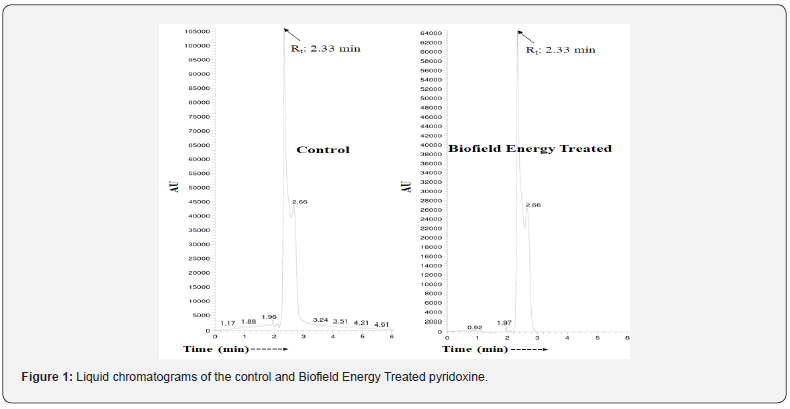
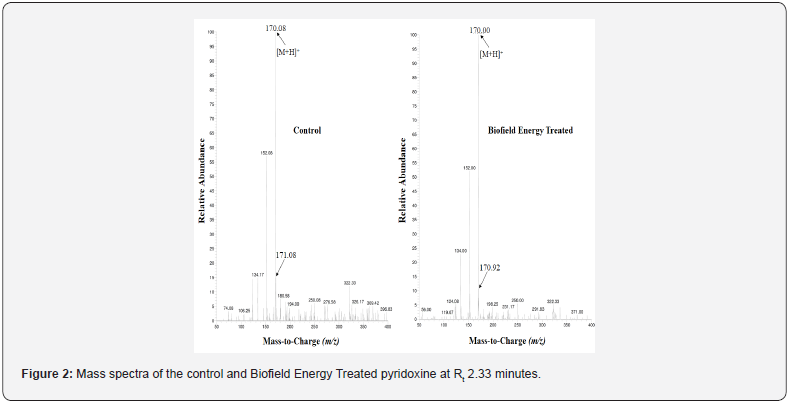

From the above calculation, it has been found that 13C and 15N have major contribution to m/z 171. The isotopic abundance ratio analysis PM and PM+1 for pyridoxine near m/z 70 [M+] and 171[(M+1) +], respectively of both the samples (Table 1). The isotopic abundance ratio PM+1/PM in the treated pyridoxine was significantly decreased by 36.94% compared with the control sample (Table 1). Therefore, it was concluded that the 13C, 2H, 15N, 17O contributions from (C8H12NO3) + to m/z 171 in the treated pyridoxine was significantly increased compared to the control sample.
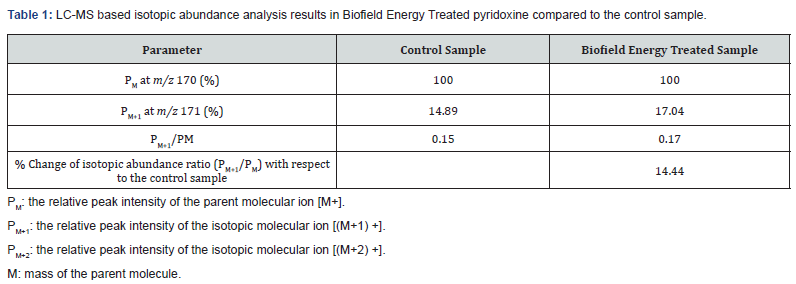
Gas chromatography-mass spectrometry (GC-MS) analysis
The GC-MS chromatographic peak was obtained at Rt ~16.7 minutes in both the samples (Figure 4 & 5), but peak area of the Biofield Energy Treated sample (83.22) was increased by 100.63% (Table 2) compared to the control sample (41.48). This indicated that the solubility of the Biofield Energy Treated pyridoxine was increased, which was supported by the recently published article [40]. Both the samples of pyridoxine exhibited the presence of the dehydrated molecular ion peak near m/z 151 (calcd for C8H9NO2+, 151.06) (Figure 4 & 5). The other mass fragmentation peak at lower m/z 124 (C7H10NO2+), 106 (C7H8N+), 94 (C6H8N+) were also observed in both pyridoxine mass spectra (Figure 4 & 5). But the mass peak intensities of the treated sample were increased compared to the control sample. The mass peak intensity of the Biofield Energy Treated pyridoxine at m/z 151 was increased by 1.1% compared to the control sample (Table 2). LCMS and GC-MS analysis confirmed the pyridoxine in the sample. The isotopic abundance ratio of PM+1/PM (2H/1H or 13C/12C or 15N/14N or 17O/16O) in the Biofield Energy Treated pyridoxine was significantly decreased compared to the control sample. Similarly, the peak area and mass peak intensity of the pyridoxine sample was improved after the Consciousness Energy Treatment. The characteristic changes in pyridoxine could be due to changes in nuclei possibly through the interference of neutrino particles via the Trivedi Effect®-Consciousness Energy Treatment [15]. Neutrino is a subatomic particle with no charge and negligible mass, which is one of the most abundant particles in the universe. Neutrinos can interact with protons and neutrons in the nucleus and the formation of isotopes [15,34,35]. The increased isotopic abundance ratios 2H/1H or 13C/12C or 17O/16O or 18O/16O would influence the atomic bond vibration of treated pyridoxine [41]. The increased isotopic abundance ratio of the treated pyridoxine may increase the intra-atomic bond strength, increase its physical stability. The Trivedi Effect®-Consciousness Energy Treated pyridoxine would be more soluble and bioavailable compared to the control sample. It would be helpful to design more efficacious nutraceutical and pharmaceutical formulations for the prevention and treatment of pyridoxine deficiency disorders, sideroblastic anemia, premenstrual syndrome, seizures, cardiovascular disease, tuberculosis, metabolic disorders, Alzheimer’s disease, cancer, hyper homocysteinemia, anxiety, hypertension, asthma, depression, dysmenorrhea, akathisia, angioplasty, birth outcomes, cognitive function, hyperkinetic cerebral dysfunction syndrome, carpal tunnel syndrome, breast pain, lactation suppression, McArdle’s disease, autism, osteoporosis, Tardive dyskinesia, etc.

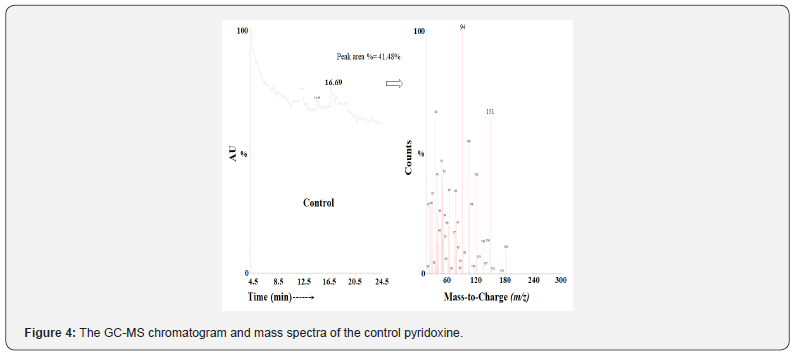
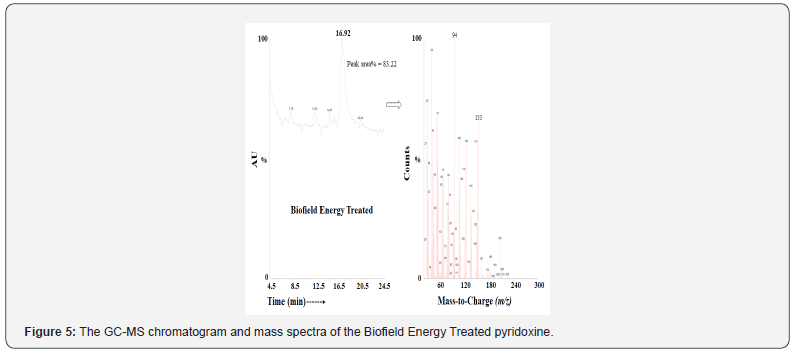
Conclusion
The Trivedi Effect®-Consciousness Energy Treatment showed a significant impact on the isotopic abundance ratio, peak area, and mass peak intensities of pyridoxine. The LC-MS spectra of both the samples at retention time ~2.33 minutes exhibited the mass of the protonated molecular ion peak [M+H] + at m/z 170 in the MS spectrum. The isotopic abundance ratio of PM+1/PM in the Biofield Energy Treated pyridoxine was significantly increased by 14.44% compared with the control sample. Thus, 13C, 2H, 15N, and 17O contributions from (C8H12NO3) + to m/z 171 in the Biofield Energy Treated sample were significantly increased compared with the control sample. Similarly, in the GC-MS chromatograms, the peak area of the Biofield Energy Treated sample was significantly increased by 100.63% compared to the control sample. Similarly, the mass peak intensity of the Biofield Energy Treated pyridoxine at m/z 153 was increased by 1.1% compared to the control sample. The isotopic abundance ratio of PM+1/PM (2H/1H or 13C/12C or 15N/14N or 17O/16O) and peak area in the Biofield Energy Treated pyridoxine was significantly increased compared to the control sample. The decreased isotopic abundance ratio of the Biofield Energy Treated pyridoxine may increase the intra-atomic bond strength, increase its physical stability. The increased peak area of the Biofield Energy Treated pyridoxine might be responsible for the increase in solubility and bioavailability compared to the control sample. The new form of pyridoxine would be better for designing more efficacious nutraceutical formulations for the prevention and treatment of pyridoxine deficiency, anaemia, seizures, cardiovascular disease, tuberculosis, Alzheimer’s disease, cancer, anxiety, hypertension, asthma, depression, dysmenorrhea, breast pain, etc.
Acknowledgment
The authors are grateful to Sophisticated Instrumentation Centre for Applied Research & Testing (SICART) India, Trivedi Science, Trivedi Global, Inc., Trivedi Testimonials, and Trivedi Master Wellness for their assistance and support during this work.
References
- WHO Model Formulary (2008). World Health Organization, p. 496.
- Falsaperla R, Saporito MAN, Stefano VD, Mauceri L, Quattrocchi E (2017) Pyridoxine supplementation during pregnancy, lactation and the first months of life: A review of the literature. Curr Pediatr Res 21: 613-619.
- (2020) US Department of Agriculture, Agricultural Research Service. 2011. USDA National Nutrient Database for Standard Reference, Release 24.
- Dakshinamurti S, Dakshinamurti K (2007) Vitamin B6 in Handbook of Vitamins. In: Zempleni J, Rucker RB, McCormick DB, Suttie JW (Eds.), (4th edn), CRC Press, Taylor & Francis Group, Boca Raton, USA, pp. 315-360.
- Nayak G, Trivedi MK, Branton A, Trivedi D, Jana S (2019) Consciousness energy healing treatment: impact on the physicochemical and thermal properties of pyridoxine HCl. International Journal of Nutrition 4: 26-37.
- Aboul Enein HY, Loutfy MA (1984) Pyridoxine Hydrochloride in Analytical Profiles of Drug Substances. In: Florey K (Ed.), Academic Press, Inc., Orlando, USA, pp. 448-478.
- AlSaad D, Awaisu A, Elsalem S, Abdulrouf PV, Thomas B, et al. (2019) Is pyridoxine effective and safe for post-partum lactation inhibition? A systematic review. J Clin Pharm Ther Retrieve, p. 27.
- (2018) Pyridoxine Hydrochloride. The American Society of Health-System Pharmacists.
- (2020) Compound pyridoxine hydrochloride section Stability
- Branton A, Trivedi MK, Trivedi D, Nayak G (2019) Evaluation of the physicochemical and thermal properties of consciousness energy healing treated cefazolin sodium. Organic & Medicinal Chem IJ 8: 555738.
- Branton A, Trivedi MK, Trivedi D, Nayak G (2019) Complementary and alternative medicine: evaluation of the physicochemical and thermal properties of the biofield energy treated metronidazole. Glob J Pharmaceu Sci 7: 555709.
- Branton A, Jana S (2017) Effect of the biofield energy healing treatment on the pharmacokinetics of 25-hydroxyvitamin D3 [25(OH)D3] in rats after a single oral dose of vitamin D3. American Journal of Pharmacology and Phytotherapy 2: 11-18.
- Trivedi D, Trivedi MK, Branton A, Nayak G, Jana S (2018) Evaluation of consciousness energy healing treated pyridoxine (vitamin B6). Global Journal of Medical Research 8(1): 15-23.
- Nayak G, Trivedi MK, Branton A, Trivedi D, Jana S (2018) The energy of consciousness healing treatment: Impact on physicochemical and thermal properties of l-tryptophan. Journal of Food Science and Technology 5: 084-094.
- Trivedi MK, Mohan TRR (2016) Biofield energy signals, energy transmission and neutrinos. American Journal of Modern Physics 5: 172-176.
- Rubik B, Muehsam D, Hammerschlag R, Jain S (2015) Biofield science and healing: History, terminology, and concepts. Global Advances in Health and Medicine 4: 8-14.
- Nemeth L (2008) Energy and biofield therapies in practice. Beginnings 28: 4-5.
- Rubik B (2002) The biofield hypothesis: Its biophysical basis and role in medicine. J Altern Complement Med 8: 703-717.
- Warber SL, Cornelio D, Straughn J, Kile G (2004) Biofield energy healing from the inside. J Altern Complement Med 10: 1107-1113.
- Koithan M (2009) Introducing complementary and alternative therapies. J Nurse Pract 5: 18-20.
- Movaffaghi Z, Farsi M (2009) Biofield therapies: Biophysical basis and biological regulations. Complement Ther Clin Pr 15: 35-37.
- Barnes PM, Bloom B, Nahin RL (2008) Complementary and alternative medicine use among adults and children: USA. Natl Health Stat Report 12: 1-23.
- Trivedi MK, Branton A, Trivedi D, Nayak G, Panda P, et al. (2016) Evaluation of the isotopic abundance ratio in biofield energy treated resorcinol using gas chromatography-mass spectrometry technique. Pharm Anal Acta 7: 481.
- Branton A, Trivedi MK, Trivedi D, Nayak G, Jana S (2019) Consciousness energy healing treatment influenced the physicochemical properties of zinc. Nov Tech Nutri Food Sci 4: 330-336.
- Trivedi D, Trivedi MK, Branton A, Nayak G, Jana S (2018) Impact of consciousness energy healing treatment on the physicochemical and thermal properties of silver oxide. Journal of Advanced Pharmaceutical Science and Technology 8: 13-24.
- Branton A, Trivedi MK, Nayak G, Trivedi D, Jana S (2018) Evaluation of the effect of biofield energy treatment on physicochemical and thermal properties of hydroxypropyl β-c J Pharmaceu Pharmacol 6: 5.
- Trivedi MK, Branton A, Trivedi D, Nayak G, Gangwar M, et al. (2015) Morphological and molecular analysis using RAPD in biofield treated sponge and bitter gourd. American Journal of Agriculture and Forestry 3: 264-270.
- Trivedi MK, Branton A, Trivedi D, Shettigar H, Nayak G, et al. (2015) Antibiogram, biochemical reactions and genotyping characterization of biofield treated Staphylococcus aureus. American Journal of BioScience 3: 212-220.
- Trivedi MK, Patil S, Shettigar H, Mondal SC, Jana S (2015) The potential impact of biofield treatment on human brain tumor cells: A time-lapse video microscopy. J Integr Oncol 4: 141.
- Trivedi MK, Branton A, Trivedi D, Nayak G, Panda P, et al. (2016) Gas chromatography-mass spectrometric analysis of isotopic abundance of 13C, 2H, and 18O in biofield energy treated p-tertiary butylphenol (PTBP). American Journal of Chemical Engineering 4: 78-86.
- Trivedi MK, Branton A, Trivedi D, Nayak G, Sethi KK, et al. (2016) Determination of isotopic abundance ratio of biofield energy treated 1,4-dichlorobenzene using gas chromatography-mass spectrometry (GC-MS). Modern Chemistry 4: 30-37.
- Schellekens RC, Stellaard F, Woerdenbag HJ, Frijlink HW, Kosterink JG (2011) Applications of stable isotopes in clinical pharmacology. Br J Clin Pharmacol 72: 879-897.
- Weisel CP, Park S, Pyo H, Mohan K, Witz G (2003) Use of stable isotopically labeled benzene to evaluate environmental exposures. J Expo Anal Environ Epidemiol 13: 393-402.
- Muccio Z, Jackson GP (2009) Isotope ratio mass spectrometry. Analyst 134: 213-222.
- Rosman KJR, Taylor PDP (1998) Isotopic compositions of the elements 1997 (Technical Report). Pure Appl Chem 70: 217-235.
- Smith RM (2004) Understanding Mass Spectra: A Basic Approach, Second Edition, John Wiley & Sons, Inc.
- Jürgen H (2004) Gross Mass Spectrometry: A Textbook. (2nd edn), Springer: Berlin.
- Aranda M, Morlock G (2006) Simultaneous determination of riboflavin, pyridoxine, nicotinamide, caffeine and taurine in energy drinks by planar chromatography-multiple detection with confirmation by electrospray ionization mass spectrometry. Journal of Chromatography A 1131: 253-260.
- Trivedi D, Trivedi MK, Branton A, Nayak G, Jana S (2018) Evaluation of consciousness energy healing treated pyridoxine (vitamin B6). Global Journal of Medical Research 18(1): 15-23.
- Santesteban LG, Miranda C, Barbarin I, Royo JB (2014) Application of the measurement of the natural abundance of stable isotopes in viticulture: A review. Australian Journal of Grape and Wine Research 21: 157-167.






























